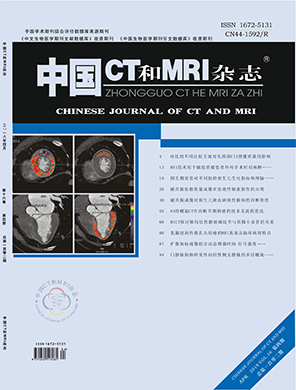摘要
目的 研究磁共振成像(MRI)对 新生儿缺血缺氧性脑病的诊断价值。方 法 选取我院2015年1月至2016年12月80 例新生儿缺血缺氧性脑病患儿为研究对 象,所有患儿均接受MRI检查,记录病灶 数量,根据阅片结果对脑损伤MRI表现进 行分型。以新生儿缺血缺氧性脑病临床分 度为标准,计算MRI分度的灵敏度、特异 度、阳性预测值、阴性预测值、准确性。 结果 本组患儿MRI检出脑水肿19例,颅内 出血24例,脑白质受损75例,9例基底节 信号异常。80例新生儿缺血缺氧性脑病患 儿共检出129枚病灶,T1WI103枚,T2WI检 出72枚,FLAIR检出117枚。80例新生儿缺 血缺氧性脑病患者根据临床症状进行分 度,轻度37例,中度25例,重度18例。以 临床分度为标准,MRI正确分度65例,轻 度诊断符合率为87.5%(70/80),中度诊 断符合率为81.3%(65/80),重度诊断符 合率为93.8%(75/80),诊断总符合率为 81.3%(65/80),Kappa值为0.707。结论 MRI可以客观反映新生儿缺血缺氧性脑病 病理特征与病变程度,对临床医师治疗指 导与预后评估具有重要作用。
Objective To study the imaging diagnostic value of magnetic resonance imaging (MRI) inneonatal hypoxic-ischemic encephalopathy. Methods 80 children with neonatal hypoxic-ischemic encephalopathy treated in our hospital from January 2015 to December 2016 were selected as subjects. All children were examined with MRI and the number of lesions was recorded. MRI findings of brain injury were typed according to the result of film reading. With the clinical grade of neonatal hypoxic-ischemic encephalopathy as a standard, the sensitivity, specificity, positive predictive value, negative predictive value and accuracy of MRI were calculated. Results In this study, MRI detected cerebral edema in 19 cases, intracranial hemorrhage in 24 cases, cerebral white matter damage in 75 cases and abnormal signal in basal ganglia in 9 cases. In 80 children with neonatal hypoxicischemic encephalopathy, there were a total of 129 lesions detected, including 103 lesions detected by T1WI, 72 lesions by T2WI and 117 lesions by FLAIR.80 children with neonatal hypoxic-ischemic encephalopathy were graded according to clinical symptoms, including 37 mild cases, 25 moderate cases and 18 severe cases. With the clinical grade as the standard, MRI grading was correct in 65 cases. The mild diagnostic coincidence rate, moderate diagnostic coincidence rate and severe diagnostic coincidence rate were 87.5% (70/80), 81.3% (65/80) and 93.8% (75/80), respectively. The total diagnostic coincidence rate was 81.3% (65/80), and the Kappa value was 0.707. Conclusion MRI can objectively reflect the neonatal hypoxic-ischemic encephalopathy and pathological features of the lesions, which plays an important role in clinical treatment guidance and the evaluation of prognosis.
【关键词】缺血缺氧性脑病;新生儿;磁 共振成像;临床分度
【中图分类号】R445.2;R722.1
【文献标识码】A
【DOI】 10.3969/j.issn.1672- 5131.2018.04.013
前言
新生儿缺血缺氧性脑病是新生儿窒息引发的持续性脑损伤,可能 对新生儿神经功能造成严重影响,导致新生儿伤残甚至死亡[1]。大量 临床研究证实,早期诊断与及时干预对改善新生儿缺血缺氧性脑病预 后与降低患儿死亡率具有重要意义[2-4]。新生儿缺血缺氧性脑病诊断方 法主要包括超声、CT、MRI等,其中MRI具有较高空间分辨率与软组织 分辨率,可以清楚判断颅内病变,减轻辐射损伤,是目前新生儿缺血 缺氧性脑病最佳检查方法。本研究选取我院2015年1月至2016年12月80 例新生儿缺血缺氧性脑病患儿为研究对象,探讨磁共振在诊断新生儿 缺血缺氧性脑病影像诊断价值。
中国CT和MRI杂志
第16卷, 第 4 期
2018年04月

相关文章